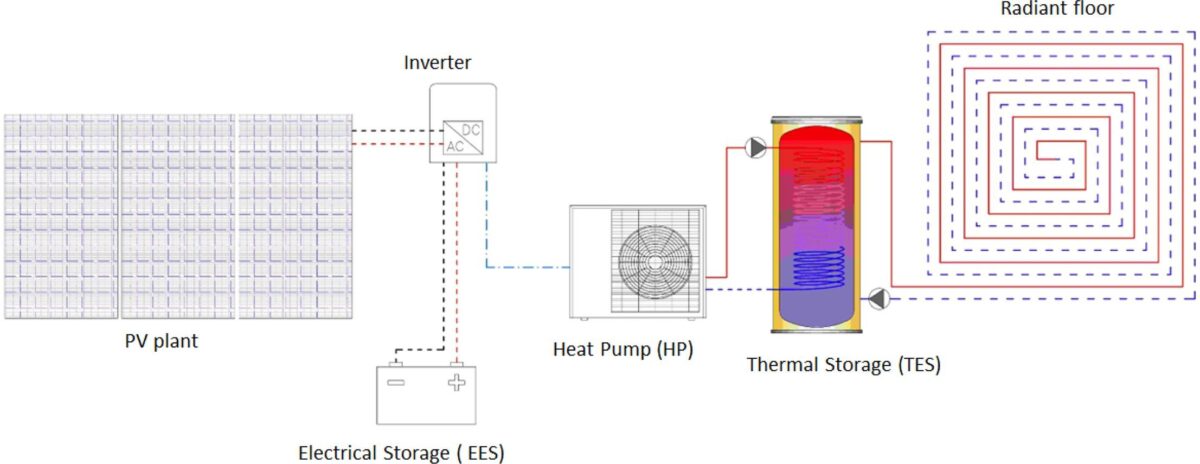If combined with both thermal and electrical storage, PV-driven heat pumps in buildings could support higher self-consumption, according to a study by University of Catania scientists. The researchers have proposed a new energy system consisting of a PV array, an electric heat pump for space heating and cooling., and two different storage systems for heat (TES) and electricity (EES).
“We are preparing an extension of this research taking into account the opportunity of using photovoltaic-thermal (PVT) instead of PV solar collectors, in such a way as to satisfy a part of domestic heating and domestic hot water production,” Prof. Antonio Gaglianom told pv magazine.
The Italian group said that their proposed configuration significantly reduces the required battery capacity by 10 kWh or more, resulting in numerous financial and environmental advantages. They noted that surplus energy from the PV plant can be used for EES charging or activating the HP for TES charging.
The scientists conducted a simulation of the system through the TRNSYS software using a reference building in Catania. The system is assumed to rely on an electric heat pump with a thermal maximum power of 9.5 kW, a radiant floor system, and a 4.8 kW PV system using 300 W panels with an efficiency of 18.4%. Their modeling also considered solar radiation, wind speed, electrical load, electricity prices, and price- and incentive-based DR programs
“The total electricity demand is 10,828 kWh/year, which means 77.3 kWh/m2 (square meter of floor), while the electricity production from PV is 8,855 kWh/year,” they said, noting that around 34.1% of the generated solar power is self-consumed. “Therefore, due to lack of available space for the installation of the PV plant, the demand coverage factor is 81.8%.”
Popular content
They said that the system could achieve self-consumption and self-sufficiency rates of about 80% if linked to a thermal storage system and a 5 kWh electrical storage system. This high percentage is three times higher than that one achievable by an energy system without storage, according to the researchers.
“It allows for reduction of the emission of at least 1,300 kg CO2 equivalent, while the requested lower capacity of the electrical storage diminishes the installation costs, of about €10,000 ($10.700), which compensate for the extra costs for the installation of the thermal storage, of about €1,500.”
The scientists introduced the system in “Improvement of energy self-sufficiency in residential buildings by using solar-assisted heat pumps and thermal and electrical storage,” which was recently published in Sustainable Energy Technologies and Assessments.
“In the future works, the modeling of charging stations and parking lots of electric vehicles for charging and discharging and exchanging with the network will be discussed,” they said. “In addition, it is possible to examine the discussion of reliability in the network.”
This content is protected by copyright and may not be reused. If you want to cooperate with us and would like to reuse some of our content, please contact: editors@pv-magazine.com.


Can someone please explain to me like I’m a child (instead of the licensed PE and 23 year veteran of the HVAC industry that I am) what this obsession is with “PV powered heatpumps” ? On my home I installed a regular old AC powered heatpump and on my rooftop I installed enough solar to 100% annual offset my home’s and cars’ energy consumption. Other than perhaps a small percentage efficiency gain from running the heatpump on DC and not having DC to AC conversion losses, what is the point? The solar panels I installed on my roof can run my heatpump AND my refrigerator AND charge my cars. Why would I want such a limited purpose built PV array for my heatpump? dont get me wrong, adding TES is absolutely the way to go. We’re pushing to try to get that in to our local energy code requirements for the next code cycle. Its great stuff. but PV powered heatpumps? I think its just a green-washing gimmick. I think thats what the contractor sells to naive little old ladies when they say they want to do something to leave a better place for their grandchildren.
@Greg – In most of these studies, the heat pumps are not directly connected to the PV; they are connected just like yours where the PV and HP and all other loads are effectively joined via an AC busbar. There is nothing special other than controlling the HP with the knowledge that PV generation is available (or will be available) which can then activate or delay the storage. Its not greenwashing, but it is a sort of communication (or marketing I guess) to describe the concept more clearly. I’m an academic working in this field, and we regularly debate the appropriateness of various KPIs for doing PV+HP+everything else since it is largely an accounting exercise. But for press releases, if you are going to get any attention you unfortunately have to play the marketing/social media game.